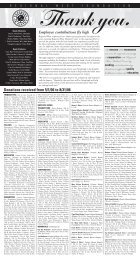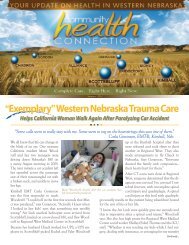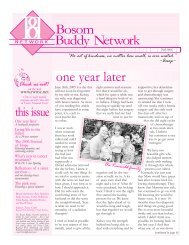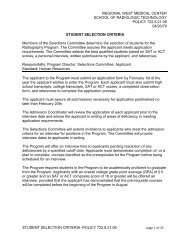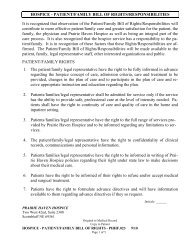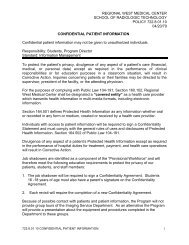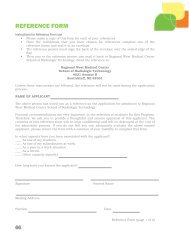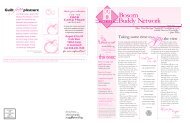School of Radiologic Technology - Regional West Medical Center
School of Radiologic Technology - Regional West Medical Center
School of Radiologic Technology - Regional West Medical Center
Create successful ePaper yourself
Turn your PDF publications into a flip-book with our unique Google optimized e-Paper software.
Hazards:<br />
A radiologic technologist may be exposed to electrical and radiant energy hazards.<br />
A radiologic technologist may be exposed to infectious diseases when radiographing patients.<br />
Technical Standards:<br />
In order to participate in this program and to be an effective radiographer, students must be able to meet<br />
specific technical standards. These include certain communication, physical, sensory, mental, and behavioral<br />
requirements to ensure the safe performance <strong>of</strong> radiologic procedures. A radiologic technologist must be<br />
capable <strong>of</strong> following technical standards in order to perform his or her duties:<br />
Sensory Requirements - Perception <strong>of</strong> the patient and surrounding environment is necessary to<br />
perform competent health assessments and interventions. Operation <strong>of</strong> equipment requires functional<br />
use <strong>of</strong> vision, hearing, tactile and olfactory senses.<br />
Examples <strong>of</strong> these requirements include but not limited to, are:<br />
• Sufficient vision and hearing to monitor condition <strong>of</strong> the patient during the radiographic procedure;<br />
ability to distinguish typical from non-typical sounds created by the operating radiographic<br />
equipment<br />
• Vision sufficient to allow accommodation between brightly lit and dimly lit environments<br />
• Sufficient vision to discriminate between gray-scale tones and image brightness associated with the<br />
radiographic image and video display monitors<br />
• Sufficient sight to read printed and computer text; observe the patient’s condition from a distance; and<br />
manipulate equipment and accessories<br />
• Ability to detect changes in environmental odors and temperatures<br />
Communication Requirements - The applicant must have the ability to use multiple communication<br />
techniques (verbal, written, nonverbal, group processes, and information technology) that enable<br />
effective communication with others. Examples <strong>of</strong> these requirements include but not limited to, are:<br />
• Speech sufficient to be understood by others; ability to understand the communication <strong>of</strong> others; understand<br />
and assess non-verbal communications<br />
• Ability to communicate pr<strong>of</strong>iciently in the English language (read, write, and speak) in order to relate<br />
with patients, patient’s families, and staff<br />
• Ability to accutately collect and document appropriate information to members <strong>of</strong> the health care<br />
team<br />
• Ability to communicate with sensitivity as well as teach, explain, direct, and counsel patients<br />
Psychomotor Requirements – The applicant must possess gross and fine motor functions necessary<br />
to perform patient assessment and diagnostic interventions. Such interventions require coordination<br />
<strong>of</strong> both the gross and fine muscular movements, stamina, and equilibrium. Examples <strong>of</strong> these<br />
requirements include but not limited to, are:<br />
Application form (page 3 <strong>of</strong> 5)<br />
64



